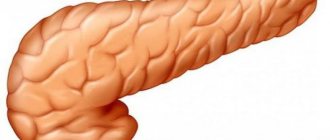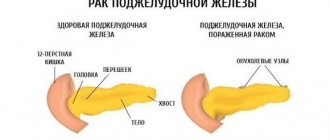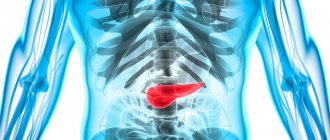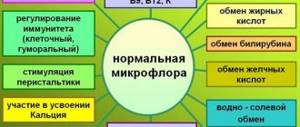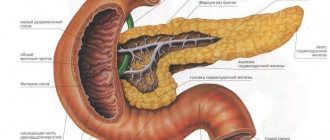Vomiting in cancer is a fairly common symptom; there are enough reasons for its development in a cancer patient. Most often, the pathological condition accompanies chemotherapy and is potentially preventable in three quarters of courses; 25% is due to a psychogenic vomiting reaction from the anticipation of vomiting itself. A vomiting reaction is often initiated by taking medications.
Chronic nausea is characteristic of extensive metastatic liver disease. Episodes of severe nausea accompany metastases and brain tumors. Sudden coffee-ground vomiting is a cause for serious concern because it indicates gastrointestinal bleeding.
Causes of vomiting in different types of cancer
The vomiting reaction is always formed “in the head,” specifically in two zones of the medulla oblongata. One of the zones is called the vomiting center; a response is formed there to the transmitted impulses in the form of a command to contract muscles in some organs or relax in others. The second area, the chemoreceptor trigger zone (CHZ), also collects “nauseous” impulses from the underlying sections and sends them to the vomiting center for response.
When impulses to the medulla oblongata come from special sensitive cells of the intestinal mucosa, this mechanism is designated as peripheral. Signals coming from the cerebral cortex or from biologically active or toxic substances circulating in the blood directly to the chemoreceptor zone form the central mechanism of nausea and vomiting. In a cancer patient, both mechanisms are activated separately or together.
The central mechanism is believed to occur in the following clinical situations:
- increased intracranial pressure due to tumor or metastatic lesions of the brain is complicated by visual and neurological disturbances, as well as a gag reaction when turning the head, and in severe cases even with synchronous opening of the eyes;
- high concentration of calcium in the blood - hypercalcemia when bone tissue is destroyed by multiple metastases or when the parathyroid glands are involved in a conglomerate of thyroid cancer;
- tumor intoxication , when toxic waste products of a cancer tumor and decay products of a tumor node are constantly released into the blood and poorly eliminated;
- psychogenic vomiting reaction due to fluctuations in psycho-emotional state or from fear of imminent nausea and uncontrollable vomiting during chemotherapy.
The peripheral mechanism is involved in the following cases:
- complications of the use of chemotherapy drugs that are toxic to nerve tissue, causing a significant decrease in intestinal motor activity until contractions stop—intestinal paresis;
- intestinal obstruction or stenosis - narrowing of the outlet of the stomach by a malignant neoplasm;
- tumor damage to the liver with a significant decrease in functionality.
The interaction of both signaling pathways to the vomiting center provides radiation and chemotherapy, in which toxic metabolites circulate in the blood and irritate the sensitive cells of the intestinal mucosa. When using high doses of narcotic analgesics, the effect of metabolites is complemented by a decrease in gastrointestinal motility, but gagging is less of a concern than almost constant nausea.
Nausea as a symptom of cancer
The urge to vomit is caused by toxins entering the bloodstream, which attack healthy cells.
The place of formation of attacks of nausea is the central nervous system. It processes alarm signals that come from the body. Those, in turn, are sent to the necessary parts of the human body (gastrointestinal tract, brain, etc.) and provoke a feeling of nausea. It may end in vomiting, but this does not always happen. It should be borne in mind that the feeling of nausea is also caused by other diseases or temporary disorders of the digestive system.
Nausea is a sign of cancer when the condition is constant and does not improve over time, but rather worsens. It is also accompanied by other complex manifestations, such as:
- unexplained loss of weight or appetite;
- persistent fatigue and headaches;
- low-grade body temperature (37° – 37.2°);
- frequent infectious diseases;
- chronic pain syndrome in bones or other areas of the body.
Types of vomiting as the disease progresses
In the medical literature, there is no classification of emetic reactions by type, since the clinical manifestation is always the same: a sharp contraction of the diaphragm and stomach with the release of gastric contents.
The appearance of the vomit itself can suggest the root cause of the pathological symptom, but not in all situations, including because as cancer progresses, the appetite suffers, the patient does not experience hunger, on the contrary, an aversion to food is characteristic, therefore the scarcity of vomit makes it difficult to analyze.
Depending on the time of occurrence of vomiting after eating, the following types are possible:
- When the passage of food through the gastrointestinal tract is blocked, vomiting mainly occurs some time after eating, when the food masses have already undergone partial digestion; brown inclusions can be detected in them - altered blood.
- During a meal or immediately after eating, the release of stomach contents is caused by an increase in pressure in the brain, psychomotor agitation, and tumor damage to the esophagus.
- In case of intoxication, metastases in the liver, complications of drug and radiation therapy, the release of vomit is possible at any time.
With some degree of probability, the appearance of the vomit can suggest the leading cause of the complication:
- almost unchanged food - cancer of the esophagogastric junction or esophagus;
- partially digested contents smelling sour - swelling of the lower third of the stomach;
- an admixture of bile is characteristic of damage to the initial parts of the small intestine;
- brown - “coffee grounds” occurs when bleeding in the stomach;
- bitter yellow contents are possible when liver function is impaired as a result of tumor damage.
When is vomiting blood dangerous?
The presence of particles of undigested food consumed in a recent meal in blood vomit often indicates a stomach upset or food poisoning, which contribute to damage to the organ by a viral infection. Prolonged vomiting provokes the appearance of greenish bile in the rejected masses. Vomiting with blood also occurs due to rupture of large vessels of the stomach.
The most common diseases, signs of which include blood in the vomit, are ulcers of the stomach or duodenum, irritation or erosion of the stomach or esophagus, and cirrhosis of the liver. In addition, blood in vomit appears as a result of dangerous diseases such as hepatitis, benign and malignant tumors.
Vomiting after radiation and chemotherapy
Severe nausea and frequent vomiting discredit an effective method of treating malignant neoplasms, so prevention and prevention of extremely unpleasant complications are no less important than selecting the optimal combination of anticancer drugs.
During chemotherapy, an acute vomiting reaction occurs during the first 24 hours, and a delayed vomiting reaction occurs in the following days after the administration of the cytostatic. There are indomitable or breakthrough vomiting and refractory vomiting, that is, not preventable by special antiemetics - antiemetics.
For all chemotherapy drugs, the emetic - emetogenic potential and methods for its prevention and treatment have been determined, and prevention must begin from the first day and be completed 2-3 days after the end of the course.
Every fourth woman after the first course may develop a reflex - psychogenic vomiting reaction; this type of vomiting is not typical for men. To stop a possible reflex reaction on the eve of the course, tranquilizers are used, acupuncture and psychotherapeutic techniques help.
During irradiation, an emetogenic - vomiting reaction does not have typical symptoms; it often depends on the irradiation zone and the patient’s internal mood. The frequency of complications is influenced by being female, youth, nervousness and life experience in the occurrence of vomiting and nausea from other causes.
How to weaken, reduce, get rid of vomiting blood, what to do?
An infusion of mint leaves, thyme and lemon balm with the addition of anise and cumin helps to reduce the intensity of vomiting and overcome nausea. The ingredients should be crushed and pour boiling water at the rate of 1 tbsp. water for 2 tbsp. l. herbs, and leave for 45 minutes. After cooling, the infusion is taken three times a day, 1 tbsp. l.
Other effective folk remedies:
1 Quince pulp (20 g) in 1 tbsp. boil. The resulting decoction, when vomiting, drink 1 tsp.
2 Orange and lemon peels (3 tbsp.) Infuse for a week in 1 tbsp. vodka. When gag reflexes appear, take 20-30 drops.
3 Drink 1 tsp every two hours. chickweed herb juice.
4 If vomiting blood occurs: cook chicken broth in boiled water. Every hour, take half a glass of broth diluted with a cup of sorrel or cranberry juice or prune compote.
Treatment methods for different types of vomiting in cancer, first aid
Oncology has achieved considerable success in the treatment of chemotherapy vomiting, despite an incomplete understanding of the mechanism of action of antiemetics. Not only standard prevention and treatment regimens have been developed, but also basic principles for taking antiemetic drugs:
- early prediction of the intensity of complications and individual selection of a combination of antiemetics;
- start taking it not when a complication develops, but ahead of time and strictly on an hourly basis;
- the advantage of intravenous and rectal forms over those taken orally - orally;
- adding tranquilizers for nervousness;
- introduction of PPI drugs into the regimen that protect the mucous membrane;
- adequate levels of microelements in the blood and a sufficient volume of circulating plasma are maintained by intravenous drips.
When vomiting, the likelihood of gastric contents refluxing into the respiratory tract in a conscious patient is minimal. If the patient is unconscious, which is possible in the terminal stage of cancer, especially with metastases to the brain or liver, the head is turned to the side, trying to tilt it lower.
It is impossible to interrupt the urge to vomit; interference with the process will worsen its course and irritate the patient. After vomiting, it is advisable to rinse your mouth and replenish lost fluid throughout the day by drinking cool water with electrolytes - rehydron - and only in small sips.
In all cases of the development of an emetic reaction, it is necessary to prescribe antiemetic drugs; an initially effective combination does not guarantee a constant result; constant monitoring of the condition and regular adjustment of the regimen are important.
Causes and mechanisms of occurrence
- Intestinal obstruction is a common complication of common malignant neoplasms. It leads to obstruction, mechanical compression, motility disorders, etc. It may be a consequence of anticancer therapy.
- Side effect of chemotherapy. Occurs immediately after treatment or after some time. In this case, toxic substances are located in the gastrointestinal tract. They stimulate a number of receptors: 5HT3, neurokine-1, cholecystokinin-1.
- In 20% of cases, the state of nausea precedes therapeutic measures. It has a lot to do with the psychological aspect. Therefore, pharmaceutical drugs are often not effective. The only remedy that combats premature nausea is a benzodiazepine. You can also use the following methods:
- behavioral changes;
- systematic desensitization;
- progressive muscle relaxation;
- hypnosis;
- acupuncture and acupressure.
- Radiation therapy may cause nausea in cancer patients depending on a number of factors:
- irradiation sites;
- total dose;
- fractionation;
- volume, etc.
Nausea with stomach cancer
Stomach cancer is accompanied by the following additional symptoms:
- general persistent disorders of the gastrointestinal tract, in particular heartburn, pain and discomfort;
- bloating and vomiting that occurs soon after eating;
- diarrhea or constipation;
- as if something was stuck in the stomach.
Drugs for the treatment of nausea in stomach tumors are prescribed according to its causes. They usually contain phenothiazines, butyrophenones and other drugs that have antihistamine and antimuscarinic properties.
Important to know: Vomiting with stomach cancer: what to do, how to stop?
Nausea with liver cancer
Often occurs due to systemic poisoning of the body by an oncological formation or the spread of a tumor beyond the primary localization. The altered chemical balance of the blood interferes with the performance of its main functions. At the same time, blood contaminated with toxic substances circulates throughout the body. It penetrates the blood vessels, transmits signals to the brain about the presence of abnormal cells and affects the corresponding receptors.
Treatment of nausea in liver cancer consists of the use of antiemetic tablets, which are determined depending on the complexity of the lesion. Steroids are often used to alleviate the general condition. They improve appetite and add energy.
Cancer cells are cells that devour healthy organs and systems at the cellular level. Through the flow of blood and lymph, they spread throughout the body in the form of metastases, causing intoxication. Medicines that try to defeat them often quickly defeat the living cells of the body. Vomiting and nausea in oncology are the body’s natural response to the disease and treatment.
The vomiting center is located in the medulla oblongata. The reflex is stimulated by impulses coming from various zones. For example, the signal may come from baroreceptors that are sensitive to increased intracranial pressure, or from chemoreceptors that respond to chemotherapy drugs. That is why understanding the mechanisms of vomiting is of important clinical and diagnostic importance.
The root causes are:
- damage to the brain itself by cancer or metastases from nearby organs;
- chemotherapy and radiation;
- drug overdose;
- liver or kidney failure;
- taking narcotic drugs.
The listed signs indicate an advanced oncological process that is not localized in the gastrointestinal tract and liver. Constant nausea and vomiting is typical in stage 4 oncology, provoked by the growth and disintegration of the tumor.
There are many causes of nausea and vomiting during chemotherapy. This is an unpleasant syndrome, but it is common. It is difficult to avoid such manifestations during cancer treatment. And the patient is prescribed medications, the purpose of which is to reduce the frequency and volume of nausea and vomiting. The drugs are called antiemetics.
Their action is based on the principles of suppressing the gag reflex and stopping the receptor areas of the brain responsible for sensitivity to irritants from the gastrointestinal tract. When antiemetics work, the activity of the central nervous system slows down, and the components of chemotherapy drugs are stopped before the corresponding signals reach the brain.
- Benzodiazepines – reducing dopamine levels, have a sedative effect on the digestive system;
- Phenothiazines – reduce the concentration of dopamine and serotonin in the blood, therefore they are used to relieve mild vomiting and nausea;
- Butyrophenones - reduce the sensitivity of nervous system receptors and reduce the severity of nerve impulses, eliminating vomiting, nausea and cough.
Doctors use similar drugs to relieve nausea and vomiting in patients undergoing chemotherapy. They reduce the sensitivity of the vomiting center, which completely eliminates symptoms. The duration of the effect of taking medications in this group is the longest of all:
- Ondansetron - the body releases serotonin, nausea appears, and the drug blocks the gag reflex;
- Granisetron – blocks the activity of serotonin receptors located in the trigger zone, which eliminates the appearance of symptoms.
Corticosteroids
The effect of drugs in this group aimed at eliminating vomiting has not been fully studied. However, it is sometimes used to eliminate these manifestations in cancer patients, recording a positive result.
Metoclopramide
They have a similar effect to butyrophenone, but are rarely used for antiemetic therapy.
Dopamine antagonists:
- Phenothiazines - act by lowering the levels of dopamine and serotonin in the body, effective only for mild vomiting or nausea.
- Butyrophenones - block receptors of the central nervous system, thereby affecting the trigger zone responsible for the mechanism of vomiting in the body.
- Benzodiazepines – have a sedative effect, reduce the concentration of dopamine in the trigger zone.
During treatment in people with cancer, doctors distinguish two types of vomiting.
These include:
- acute vomiting, which manifests itself during the first day after the start of therapy;
- delayed vomiting, which manifests itself within 2 or 5 days after the start of therapy.
In the delayed version, antiemetic drugs after chemotherapy are taken until the urge to vomit completely disappears.
Your doctor will tell you what to do if negative symptoms that affect your quality of life appear. Today, oncology uses a large number of antiemetic medications in the form of solutions, tablets, suppositories, syrups and injections. The doctor selects the most effective drug in each specific case.
In case of brain cancer, antiemetics are powerless; in this case, a high dose of hormones and diuretics are prescribed. Fluid intake is limited during treatment. For stomach and intestinal cancer, a special diet is prescribed along with medications. If a person develops vomiting due to metastasis of cancer cells from leukemia (leukemia), he is prescribed a high dose of hormones and peripheral anti-nausea and vomiting drugs, such as Motilium.
Today, various methods and recipes are used to treat and prevent vomiting in cancer pathologies. But the most effective are serotonin receptor antagonists, which include Ondansetron and Zofran. They help improve the quality of life of patients. They also provide the opportunity to undergo chemotherapy at home. They are taken half an hour before using the cytostatic drug.
What type of cancer can cause bleeding?
The most common type of gastric carcinoma is infiltration with ulceration or ulcerative-infiltrative type; the size of the lesion and ulcerative defect can be any size, up to total damage to the organ. A cancer ulcer has rough, protruding and uneven boundaries; its walls and bottom form a kind of folded funnel. Saucer-shaped carcinoma is distinguished when the ulcer has very clear and uniform boundaries.
In addition, cancerous infiltration can pass through the gastric wall and penetrate into the pancreas and pull the abdominal omental bursa into the conglomerate. Even with tiny early cancer with a minimal ulcerative defect, organ-preserving surgery - mucosal resection - is excluded, because the true boundaries of the tumor are in the deep layers of the gastric wall.
The ulcerative form of cancer in appearance is almost no different from a banal chronic gastric ulcer, and that is why during each gastroscopy, a biopsy is taken from the edges of the mucosal defect from all absolutely ulcer patients.
It is almost impossible for carcinoma growing outside the stomach to bypass the vessel, because in the thickness of the wall the arterial vessels form four interconnected vascular networks: inside and under the mucous layer, between the muscular and under the serous layers. That is why bleeding is the most common complication of the disease.
What is stomach cancer?
The pancreas is an organ that, in the presence of a cancerous tumor, does not give a pronounced symptomatic picture in the early stages of development.
In this regard, most people who ignore the need for regular preventive medical examinations may not even realize that they are living with cancer. Symptoms appear gradually, people attribute the deterioration of their condition to a disease such as pancreatitis, try to self-medicate, go on a diet, and only when the attack becomes unbearable do they seek medical help. But this happens at a stage when fighting the tumor is no longer useful.
What is the danger of stage 3 pancreatic cancer? An oncological tumor, uncontrolled by treatment, begins to grow and metastasize throughout the body, affecting the lungs, liver and other internal organs.
The fourth stage of pancreatic cancer is not subject to conservative treatment, and it is not always possible to remove the focus of a cancerous tumor if metastases have already begun to spread throughout the body, affecting all internal organs.
Chemotherapy and radiation therapy are methods aimed at slowing down the spread of metastases, but they give side effects that the body, weakened by a cancerous tumor, cannot always cope with.
The survival rate of patients diagnosed with stage 4 pancreatic cancer is no more than six months to a year, and only in rare cases is it possible to live with this pathology for up to 5 years (no more than 5% of all patients).
Such unfavorable prognosis is due to the fact that even the most effective method of cancer treatment - surgery - does not make sense at stage 4. Even if part of the pancreas or the entire organ is removed, it is not possible to cut out the metastases.
In this case, there is a high risk that the patient may not survive the operation.
Gastric cancer is a malignant degeneration of gastric epithelial cells. In 71-95% of cases, the disease is associated with damage to the stomach walls by Helicobacter Pylori bacteria and is a common cancer in people aged 50 to 70 years. Men are diagnosed with stomach cancer 10-20% more often than women of the same age.
Epidemiology
Symptoms of cancer at first may not differ from common gastritis or ulcers. It is the similarity of symptoms that influences diagnosis.
Typically, a person experiencing pain or nausea does not think about cancer and puts off visiting the doctor. Some try to eliminate unpleasant symptoms by taking folk remedies.
In this case, valuable time is lost. However, remember that it will be possible to live as long as possible with cancer only when the disease is detected at an early stage and intensive treatment begins.
A person may have alimentary canal cancer if they have the following symptoms:
- constant heartburn;
- nausea;
- weakness for no reason;
- loss of appetite;
- weight loss;
- apathy and depression;
- sleep disturbance;
- stomach pain;
- pallor;
- feeling of fullness after eating, heaviness;
- quick satiation with food.
Although such manifestations can be the cause of many other diseases, if you have persistent stomach pain, you should visit a doctor. Such signs are more typical for the first stage of cancer. With stage 4 cancer, symptoms increase.
There is extreme exhaustion of the body. Vomiting becomes uncontrollable.
The pain radiates to the back or lower back and becomes very strong and unbearable. Anemia develops.
In addition to such signs, stomach cancer is accompanied by gastrointestinal bleeding. You can suspect internal bleeding by the color of the stool.
It turns black due to the presence of blood. At this stage, the patient feels a deterioration in his general condition every day.
He suffers from attacks of dizziness and cold sweat. Body temperature rises.
When the cells of each organ divide, cells with an incorrect DNA structure periodically appear, which ensures their structure is disrupted. But the immune system comes into play and “sees” that the cell is abnormal by the antigen proteins that appear on the surface of its membrane.
T-lymphocyte cells, performing their daily work, must “check” the antigens of all cells that are not fenced off by a special barrier with the data about the norm that they have in their memory. When the test data is not as expected, the cell is destroyed.
If this mechanism is disrupted, the mutated cells also begin to divide and, accumulating, give rise to a cancerous tumor. Before reaching a certain critical number, they turn on a mechanism that hides them from the immune system.
Then, when this volume is reached, the defense forces recognize the tumor, but they are not able to cope with it on their own. Their struggle causes the appearance of early symptoms.
Clinical signs of blood loss
Severe blood loss is manifested by a rapid decrease in blood pressure and associated progressive weakness. Exsanguination is manifested by pronounced waxy pallor with blue lips against the background of an increasing heartbeat, which the cancer patient feels like hammer blows inside the chest. The patient becomes covered in sticky cold sweat and may lose consciousness.
The most common sign of gastric bleeding is bloody vomit, commonly referred to as “coffee grounds.” Bloody vomit is typical for damage to the vessels of the respiratory tract; a sign of acute gastrointestinal pathology is dirty-brown food masses with an unpleasant odor, which may also contain dark clots of coagulated blood. Blood entering the lumen of the stomach undergoes fermentation with the release of iron from red blood cells, which changes the natural scarlet color of the blood to dark brown.
As blood passes through the intestinal tube, iron released from dead red blood cells will color the stool and the color of the stool will also change to black, again due to fermentation by intestinal secretions. Often, in a cancer patient, the stool liquefies and comes out in the form of a tarry paste with an extremely unpleasant odor. Increased frequency of stools with changes in consistency and color is called “melena.”
The combination of dark vomiting food masses and black feces are the leading signs of gastric bleeding of any etiology, including carcinoma. Foul-smelling vomit is typical of gastric or colonic outlet obstruction, but its color is not dark brown, although it differs from the food eaten the day before. The clinical situation requires immediate seeking emergency medical help, especially in combination with black stools, even against the background of good health.
Treatment of hematemesis
All patients with hematemesis are referred for urgent gastroscopy, during which they try to detect the source in the form of a gaping vessel and carry out conservative measures to stop the bleeding.
Many methods have been developed for local control of bleeding during endoscopy; often several methods are used in one patient. They resort to hypothermia with an ice solution, hemostatic agents and various methods of coagulation and vascular embolization. It is especially difficult with profuse leakage, when the blood seems to be oozing from the wall and not a single damaged vessel is visible.
The frequency of relapses after endoscopic control of blood loss is also significant, so the possibility of performing surgery on a cancer patient is mandatory. A radical measure is removal of the stomach, but emergency intervention immediately after the bleeding has stopped results in high postoperative mortality, therefore, if possible, the patient is actively prepared for a planned surgical intervention within several days.
Treatment of a bleeding stomach is a very difficult task, requiring only an individual therapeutic approach with the clinic being well equipped with modern operating and diagnostic equipment. To this, our clinic adds vast experience in endoscopic interventions in complex cancer patients.
Cancers at the last stage are serious, in most cases, incurable diseases, in which only the patient’s condition can be alleviated. Vomiting in stage 4 cancer is a fairly common symptom that brings a lot of suffering to a person with cancer.
Types of stomach cancer
Stomach cancer is divided according to location and methods of spread - this could be, for example, squeezing out surrounding tissue or, conversely, infiltration into surrounding tissue. Histological forms of cancer: diffuse or polyp-like have a significant influence on the pathogenesis.
Signet ring cell cancer of the stomach
Diagnosed by cytological and histological examination. This is a type of diffuse cancer. The changed area consists of flat signet ring cells. The disease has an aggressive course.
Histochemical studies have established the hormonal nature of this tumor. In the tissues of the neoplasm in women, an increase in the level of estrogen is found, and in men - testosterone.
Distinctive features of this type of disease:
- Predominance of women in the structure of patients. The number of sick women is 55%, men are 45%. The ratio may vary, but the pattern has been confirmed by numerous studies;
- Peaks of incidence in the age intervals from 40 to 50 years and 60-70 years. At other intervals of life, such cancer is diagnosed significantly lower;
- The structure of patients is dominated by people with blood group A (II) - about 45%, with other variants of blood groups significantly lower.
- The dependence of the onset of the disease on the presence of previous bad habits (drinking alcohol, salted, smoked, pickled foods) and exogenous factors (working with radiation, in chemical production) has not been established.
- This type of stomach cancer is more often found in urban residents.
Infiltrative stomach cancer
Morphological form of carcinoma, without clearly delineating the boundaries of the neoplasm. The growth of malignant cells occurs mainly in the thickness of the stomach wall.
Features of the disease:
- May occur in relatively young people, hereditary predisposition is noticeable;
- Small foci of cancer cell growth are found at a distance of 5-7 cm from each other;
- This is one of the most malignant forms of cancer and often metastasizes;
- The pathogenesis of the clinical stage is accompanied by symptoms associated with dyspeptic symptoms (chronic vomiting, impaired peristalsis);
- In the last stages, the tumor is defined as a dense stone-like formation, the stomach decreases in size.
Poorly differentiated gastric cancer
Normal epithelial cells renew themselves at a high rate; after about 3-4 days, a generation is completely replaced. High update speed is an important factor in the occurrence of defects.
The high rate of reproduction of poorly differentiated cells underlies the aggressiveness of cancer pathogenesis. Poorly differentiated gastric cancer is a form of gastric adenocarcinoma composed of stem cells.
- High growth rate, development of inflammatory and necrotic foci around the tumor;
- The inability to determine the type of changes is the hidden development of carcinogenesis in the thickness of the stomach wall;
- The absence of clear boundaries of the tumor, growth occurs as a diffuse impregnation of the walls of the stomach;
- Rapid formation of metastases in regional lymph nodes and distant organs: metastasis reaches 90% of all cases of low-grade tumorigenesis.
Depending on the type of cancer, one or another symptomatology accompanying the diagnosis is observed, characterizing the specificity and intensity of the manifestations:
- polypoid - grows mainly in the gastric lumen, therefore it is almost always accompanied by intense pain. As a rule, this is a single tumor that reaches large sizes and is relatively easy to palpate. It is characterized by bloating, nausea and spontaneous bouts of vomiting;
- infiltrative – diagnosed in every second case. It has ulcerative manifestations and an irregular, lumpy shape. It is characterized by rapid weight loss, general weakness and fever already in the early stages of the disease;
- diffuse – diagnosed extremely rarely. Significantly thickens the walls of the organ and provokes excessive outflow of mucus. The main symptom is a pronounced enlargement of the stomach.
For pancreatic cancer, classification is based on the histological structure of the tumor, the presence of regional and distant metastases and the localization of the pathological process. The following types of cancer are distinguished:
- ductal adenocarcinoma;
- cystadenocarcinoma;
- squamous cell carcinoma;
- mucinous adenocarcinoma.
In the first case, the neoplasm develops from the tissues of the gland ducts. This pathology is more often diagnosed in men. Of all exocrine tumors of the gland, it is the most common (in 80% of cases). This form of cancer is aggressive in nature. The mortality rate is almost equal to the incidence rate.
Sometimes malignant neoplasms developing from the cyst are detected. These are cystadenocarcinomas.
They appear as a result of malignancy (degeneration of normal cells into malignant ones). Less common is mucinous adenocarcinoma of the gland.
Its difference is in the presence of large inclusions of mucus. This is a rare form of breast cancer.
The tumor can form from the epithelium of the organ mucosa. In this case we are talking about squamous cell carcinoma.
Depending on from which cells the malignant tumor developed (this determines its properties), it can have several types:
- Ductal adenocarcinoma is a cancer that develops from the cells lining the excretory ducts of the gland. The most common type of tumor.
- Glandular squamous cell carcinoma is formed from two types of cells - those that produce enzymes and those that form excretory ducts.
- Giant cell adenocarcinoma is a collection of cystic, blood-filled cavities.
- Squamous cell carcinoma. Consists of duct cells; is extremely rare.
- Mucinous adenocarcinoma occurs in 1-3% of pancreatic cancers. It is less aggressive than the previous form.
- Mucinous cystadenocarcinoma develops as a result of degeneration of a gland cyst. This form of cancer most often affects women.
- Acinar cancer. Tumor cells here are arranged in clusters, which gives rise to the name of the tumor.
- Undifferentiated cancer. Its most malignant type.
If cancer develops from the endocrine part of the gland, it may be called:
- glucagonoma - if it produces glucagon, a hormone that increases blood sugar levels;
- insulinoma, which synthesizes excess insulin, which reduces blood glucose levels;
- gastrinoma - a tumor that produces gastrin - a hormone that stimulates the stomach.
Depending on the location, there are:
- pancreatic head cancer. This is the most common type of malignant tumor;
- gland body carcinoma;
- pancreatic tail cancer.
If you combine the 2 above classifications, then scientists give the following statistics:
- in 61% of cases, ductal carcinoma is localized in the head, in 21% in the tail, in 18% in the body;
- the head of the gland provides “shelter” for more than half of giant cell adenocarcinomas;
- in more than 60% of cases, glandular squamous cell carcinoma is located in the head of the organ, less often its foci are multiple or located only in the tail;
- localized in the head and more than 78% of mucinous adenocarcinomas;
- the localization structure of acinar cell carcinoma is as follows: 56% is located in the head, 36% in the body, 8% in the tail;
- But mucinous cystadenocarcinomas are located in the head in only 1/5 of cases, more than 60% affect the body, and in 20% of cases they are localized in the tail.
Thus, we can conclude that the head of the pancreas is the place where a malignant tumor is most often found.
Why does vomiting occur with stage 4 cancer?
Below are the main reasons for this phenomenon:
- Damage to the brain by metastases, which increases pressure inside the skull.
- Taking antitumor drugs.
- Taking narcotic drugs to alleviate the patient’s condition (a few days after starting to take such medications, in most cases, vomiting goes away on its own).
- Intoxication that occurs against the background of an enlarged tumor and metastases.
- Liver failure observed in patients at the last stage of cancer.
- Vomiting can also occur during radiation therapy.
- Damage to the digestive system is another factor in severe vomiting.
- Psychological reasons, stress, depressive states.
Medicines to eliminate
Dealing with nausea due to cancer is not easy. First you need to establish the exact cause, and then take action. Traditional medicine is not always able to give the desired result. Therefore, it is important to know the remedies that effectively affect and eliminate nausea. These include:
- 5-HT3 antagonists block the action of serotonin on the surfaces of nerve endings: “Dolasetron”, “Granisetron”, “Ondansetron”, “Tropisetron”.
- Corticosteroids. Dexamethasone has a special effect. The drug gives a positive result for many causes of nausea (even with chronic nausea of a metastatic cancer process).
- Anti-NK1 receptor agents, e.g. They control the production of elements in the brain stem and gastrointestinal tract.
- Simultaneous use of the three named drugs.
- Prokinetic agents, in particular Metoclopramide, which affects the muscular lining of the intestines.
- Drugs that block dopamine: Haloperidol, Olanzapine, Levomepromazine, etc.
- Antihistamines (“Promethazine”, block D2), affecting the mechanisms that cause vomiting and the vestibular nuclei.
- Anticholinergic drugs (“Scopolamine”). Relieves tension in the stomach muscles and reduces the secretion of gastric juice.
- Analogues of “Somatostatin”, which are used for palliative purposes.
Nausea with cancer is common. It requires careful choice of management, since it can greatly aggravate the condition of a person with cancer.
What kind of vomiting occurs in such patients and what does it mean?
Depending on the consistency and color of the vomit, the degree of cancer development can be determined.
Vomiting without blood occurs when the affected tissues rupture, as well as when putrefactive processes develop in the affected organ. At the last stage, such vomiting appears regularly. In cases of cancer, the volumes of vomit are in most cases small, and they have a specific sour smell of decomposing tissue.
Vomiting blood is another phenomenon in advanced oncology, which indicates vascular damage. Blood can occur when a tumor is damaged, which has many vessels that support its growth. If the vomit is scarlet in color, this indicates extensive internal bleeding.
Black vomiting indicates hidden bleeding, which is no less dangerous for the patient’s condition. If transparent mucus appears in the masses, we are talking about a failure in gastric secretory function.
Light masses with bile impurities are direct evidence of blockage of the ducts, a consequence of the formation of metastases in the liver (such vomiting is characterized by frequent urges).
Vomiting in the last stage of cancer may occur immediately after eating (in this case, the bolus of food is pushed back by the body without gastric juice). Nausea can occur suddenly and regardless of food intake, this occurs when the tumor disintegrates.
Vomiting and nausea in oncology: how to overcome the condition
page Vomiting
Rejection of stomach contents in cancer patients is a common problem. Vomiting in oncology can be caused by chemotherapy, as a complication, the spread of metastases, or for other reasons. There is no universal drug that relieves the patient of such symptoms. Doctors resort to medications that can, to some extent, stop the vomiting syndrome.
Features of vomiting in oncology
Vomiting is dangerous for a cancer patient. Increases the risk of dehydration, which is a prerequisite for thrombosis. With an unremoved tumor or actively developing metastases, the blood clotting mechanism is disrupted. Eruption of contents occurs for the following reasons:
- Chemotherapy or waiting for the procedure. It is almost impossible to predict the response to therapy; it is individual for everyone. Various factors influence the occurrence of nausea during chemotherapy.
- Brain tumors in which blood pressure rises, causing nausea.
- The spread of metastases in the liver causes an unpleasant condition. The patient experiences weakness, fever appears, and the skin becomes yellowish.
- Diseases that have an inflammatory or infectious etiology.
Irritation of the receptors causes a gag reflex. When affected by intestinal or stomach cancer, the reflex appears at the slightest irritant. Such diseases are not treated only by nausea. Added to the unpleasant symptoms are indigestion, indigestion and bloating.
At what stage of cancer does nausea and vomiting develop?
Nausea appears at the fourth stage of oncology. It can occur after eating, when the food consumed has not yet begun to be digested.
If the condition is a rare occurrence and does not contain blood impurities, it is enough to take antiemetic drugs to ensure peace for the patient. In some cases, the body's rejection of vomit leads to death. Frequent urges cause complications:
- dehydration of the body;
- constant nausea contributes to the development of pathological conditions of the cardiovascular system;
- internal bleeding;
- the appearance of thrombosis.
If the discharge turns black or contains blood clots, this is a reason for urgent medical intervention. Signs indicate bleeding, which, if not stopped in a timely manner, leads to death.
Vomiting mainly occurs with stage 4 cancer. This is due to the following reasons:
- with a brain tumor at the last stage, metastases completely affect the organ, due to which intracranial pressure increases;
- complications after anticancer drugs;
- taking painkillers based on narcotic substances;
- intoxication that occurs when a malignant tumor enlarges or metastases are activated;
- psychological reasons associated with a long struggle for life, stress and depression.
A dangerous condition is if the urge occurs more than 3 times during the day. When the tumor disintegrates, nausea appears randomly.
What happens and what does it mean?
The characteristics of vomit can say a lot about the extent of the disease. When examining the contents of vomit, attention is paid to color and consistency. Their nature may indicate certain disorders in the body:
- vomit without blood indicates that putrefactive processes have begun in the organ affected by the tumor. The contents have a sour smell, but the volumes are not large. At the last stage of the disease, reflex vomiting becomes more frequent;
- vascular damage causes vomiting of blood. If the tumor has many vessels, if their integrity is violated, the masses become red;
- vomiting black masses is a sign of bleeding. The appearance of clear mucus indicates a malfunction of the gastric function and has dangerous consequences;
- frequent nausea of light masses with small admixtures of bile indicate the formation of metastases in the liver. Their reproduction clogs the ducts, preventing the organ from working productively;
- Green vomiting in oncology is a sign of the presence of bile. Repeated symptoms increase the concentration of bile, the vomit turns green. This manifestation indicates a deterioration in the condition of the liver or the activation and proliferation of metastases;
- Vomiting of feces in a cancer patient is caused by intestinal obstruction. When a blockage occurs in one of the sections of the gastrointestinal tract, fecal contents accumulate in this block, gradually expanding it. Mechanical enlargement of the intestines causes a gag reflex, as a result of which the patient loses electrolytes. A cancer patient cannot go to the toilet and have a bowel movement naturally. The abdominal area gives off heaviness and discomfort. If treatment with conservative therapy does not bring results, surgical intervention is resorted to.
Treatment methods for the condition
Treatment methods for symptoms of cancer depend on the etiology of the process. There is definitely no universal remedy that is equally successful for different patients.
Despite the huge list of various medications intended to relieve the gag reflex, doctors advise starting or combining drug therapy with physical procedures.
Non-drug therapy includes:
- A massage that allows the patient to relax.
- Swimming in warm water in the absence of contraindications.
- Walking in the fresh air without overworking the body.
- Mint tea.
- Light gymnastics.
Such treatments are useful as a calming factor - the process of fighting cancer is stressful. Patients become depressed and live with a constant feeling of fear and uncertainty.
It is necessary to treat nausea not only for reasons of comfort. Such pathological conditions cause negative consequences, such as exhaustion of the body, large loss of fluid and drug intoxication. Together with the vomit, the patient loses the strength the body needs in the fight against cancer. Doctors often advise sticking to a balanced diet and replenishing the water-salt balance.
Antiemetic therapy is represented by a large number of drugs in the form of tablets, solutions, syrups and injections. The attending physician, who is aware of the dynamics of the disease, should select the type and class of the drug. Self-prescribing medications is prohibited; some medications will be useless.
To relieve nausea, the following is prescribed:
- Antagonists. It affects the vomiting center, blocking the urge.
- M-cholinergic receptor blockers affect the muscles of the stomach and pancreas. The drugs relax and slow down the reflux of contents.
- Glucocorticosteroids have a wide range of effects and are good at blocking vomiting syndrome, preventing it in the future.
- Prokinetics that block dopamine receptors.
The choice of antiemetic drugs is large, the range of actions lies in the restoring effect of water balance.
Loading …
First aid for persistent vomiting
A person may feel sick several times a day, become weak, lethargic, and lose weight. When the symptom is profuse and does not stop, and the masses contain stool impurities or are greenish in color, you need to call an ambulance and wait for an oncologist to come to your home. Before medical professionals arrive, first aid must be provided. It consists of the following actions:
- To prevent vomit from entering the respiratory system, turn the patient on his side and tilt him slightly forward.
- Place an ice compress on the patient's stomach and perform another cooling procedure. This action can narrow blood vessels and reduce bleeding.
- Offer the patient something to drink to avoid dehydration.
- At the first signs of large fluid loss, the patient must be given solutions that restore the water-salt balance.
The main rule is to wait for qualified help. It is prohibited to dispense any medications yourself.
Treatment of vomiting after intestinal surgery for oncology
Vomiting after intestinal surgery for oncology is a common complication. The operation is planned and involves preparation for surgery. Relatives should be informed about the progress of the operation, pain relief, expected results and possible complications.
To reduce the risk of vomiting after intestinal surgery, doctors advise adhering to the following recommendations:
- before surgery, perform cleansing enemas;
- network on a slag-free diet;
- taking laxatives;
- After surgery, you must follow a diet. Light food simplifies the body's task in digesting it;
- Drink enough fluids to avoid constipation.
The recommendations will reduce the risk of vomiting after surgery.
Surgery for intestinal cancer is resorted to in extreme cases. The operation is often traumatic; during surgery it is necessary to completely or partially remove the affected tissue. Usually limited to therapeutic procedures:
- radiation therapy. Requires a long time and equipment, not so dangerous. It causes the symptoms discussed above as side effects. Based on the sensitivity of tumor cells to certain types of radiation. The procedure is aimed at maximizing the preservation of healthy cells and the destruction of diseased cells;
- chemotherapy procedures. Drugs are used to which cancer cells react fatally.
Sometimes these methods can be combined: carried out simultaneously or sequentially. After several courses of such therapy do not bring positive dynamics, doctors decide on surgical intervention.
//www.youtube.com/watch?v=HvH34Iqvbp8
Symptoms after surgery may be associated with depressive disorders. The mental state of the patient is important in the process of fighting cancer, so you should not neglect consultation with a psychologist.
The article has been approved by the editors Link to main publication
articles:
(2 5,00 of 5) Loading...
Source: //toxikos.ru/rvota/pri-onkologii
How can vomiting be dangerous for a cancer patient at stage 4?
If the vomiting does not contain blood in the masses, urgent specialist intervention is not required; it is enough to take special antiemetics and provide rest to the patient. However, in some cases, vomiting can lead to the death of the patient.
So, urgent intervention is required if you find blood clots in the masses, or the vomit has turned black. In this case, we can talk about internal bleeding, which, in the absence of timely medical intervention, can lead to death.
When is a doctor needed?
Any deterioration that could lead to death requires urgent medical intervention. These include:
- the appearance of scarlet blood or blackened thick matter in the masses;
- immediate rejection of any antiemetics taken;
- no urge to go to the toilet;
- vomiting for more than 24 hours or more than 3 times in 3 hours.
ATTENTION! The information on the site is provided for informational purposes only! No website can solve your problem in absentia. We recommend that you consult your doctor for further advice and treatment.
- Vomiting of bile and diarrhea in an adult – VospalenieKishechnika
- Diet for stomach cancer: nutrition before and after surgery, what should be excluded from the menu
- Indicators of ESR in the blood in oncology
- Is it possible to dye your hair during chemotherapy and radiation - precautions, risks and consequences
First aid for cancer patients who are vomiting
If the vomiting is profuse and continuous and black in color, it is extremely important to provide first aid to the patient before the ambulance arrives. Put the patient to bed and try to provide him with maximum peace. Next, follow these instructions:
№1:
During an attack, carefully turn the patient onto his side and tilt his head slightly (this will prevent vomit from entering the respiratory system). After this, place a cold compress with ice on the cancer patient’s stomach, which will reduce discomfort and also stop internal bleeding, if any.
№2:
If there is a suspicion of internal bleeding in the lung area, a compress should be applied to the chest. To prevent severe dehydration, offer the patient warm drinks in the form of herbal infusions or sweet tea.
№3:
In order to maintain electrolyte balance in the body, it is better to use ready-made solutions, which should always be in a cancer patient’s medicine cabinet (for example, the “Regidron” solution, intended for oral administration, is effective). If possible, it is recommended to give medications that are available without a prescription (these can be antihistamines, for example, Suprastin, which will alleviate the patient’s condition).
Important:
Eating food immediately after the attack is over is strictly prohibited!
How to help a patient?
General tips for relieving cancer nausea include:
- Use of any medications prescribed without a prescription:
- “Meclozine” (“Antivert” or “Bonine”);
- “Dimenhydrinate”;
- Antihistamine.
- Drinking enough liquid. Drink in small sips and often.
- Meals should be divided into 6-8 small portions.
- Avoid salty, fried, too sweet or spicy foods.
- At the next attack, suck on a mint candy or refreshing chewing gum.
- Drink teas and decoctions of medicinal herbs, in particular ginger, mint, lemon balm, milk thistle, and flax.
Important to know: Nausea after chemotherapy: how to quickly eliminate it?

